Field service teams manage urgent work orders, complex routing, and growing customer demands, while losing hours to manual scheduling and paperwork.
Agentforce for Salesforce Field Service automates job assignment, fills schedule gaps in real time, and provides technicians with clear step-by-step guidance to resolve issues quickly and safely. For example, Axis Water saw technicians start 30+ minutes earlier per day after deployment, thanks to automated scheduling and pre-work briefs. Learn about the importance of Agentforce for Field Service operations and how to take the most out of its capabilities.
Why Agentforce is Critical for Field Service
Field service operations are fast-paced, unpredictable, and often stretched thin. Dispatchers must coordinate dozens of moving parts while technicians navigate traffic, locate parts, and resolve complex issues on-site, all under the pressure of tight SLAs. Agentforce for Field Service introduces a new model that works alongside human teams to eliminate bottlenecks, predict issues, and provide real-time support. Embedded in Salesforce Field Service, Agentforce automates assignments, surfaces schedule fixes when plans change, and gives techs guided workflows, so jobs are assigned, executed, and closed out with fewer handoffs.
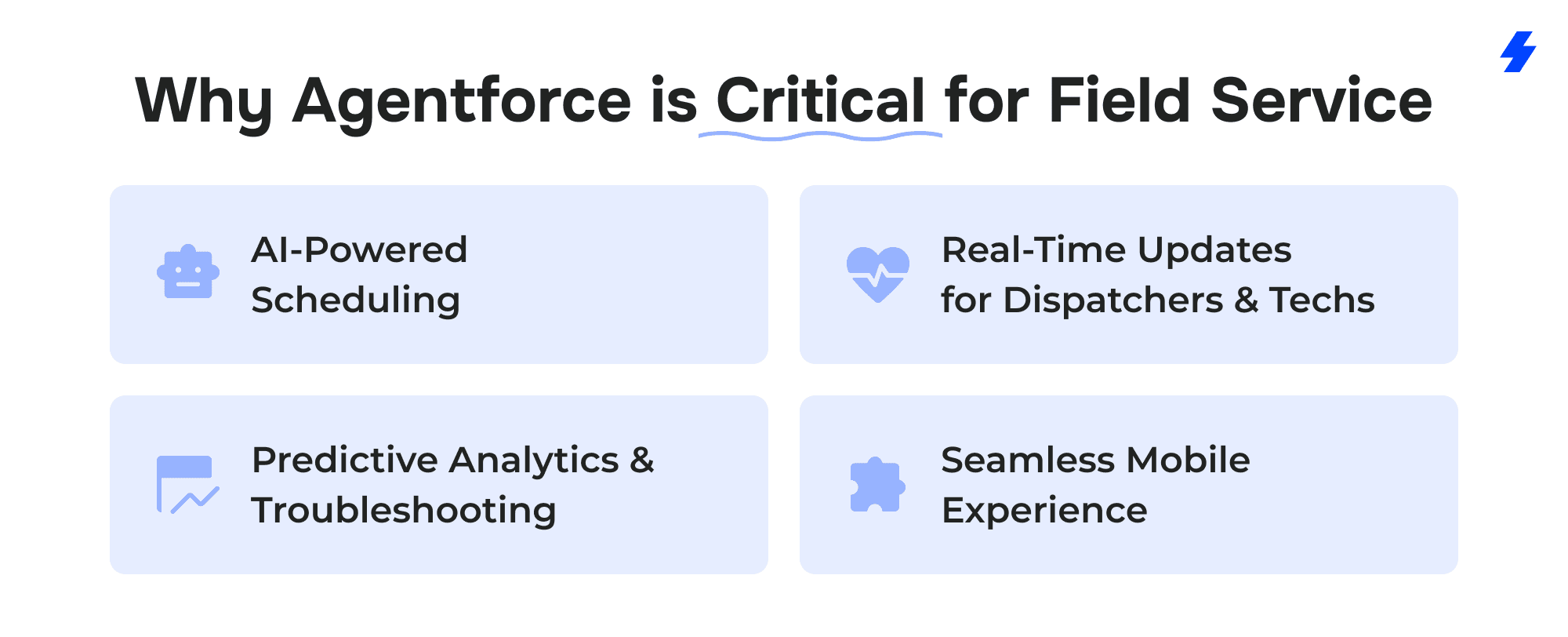
AI-Powered Scheduling
One of the biggest productivity drains in field service is scheduling. Manual appointment changes consume minutes per job and create errors at scale.
Agentforce solves this by automating job assignments based on technician skills, certifications, location, availability, and travel time. It uses natural language to understand customer requests, creates the work order, and suggests the best available time slots. This eliminates scheduling bottlenecks and helps teams handle more jobs per day without adding headcount. Many companies are already seeing faster response times and reduced administrative burden thanks to this automation.
Real-Time Updates for Dispatchers & Techs
Unplanned changes, such as no-shows, cancellations, or early job completions, can disrupt even the best-planned schedule. Traditionally, dispatchers scramble to fill gaps while technicians waste time waiting for updates.
Agentforce brings real-time optimization to this process. It detects schedule gaps instantly and suggests the best replacement jobs by factoring in travel distance, part availability, and technician skills. Dispatchers can apply these updates with one click, while technicians receive immediate notifications on their mobile app. They can even trigger Agentforce through Siri shortcuts (Siri integration is custom), launching the AI assistant hands-free to accept jobs, request support, or check their schedule while on the road.
Predictive Analytics & Troubleshooting
Many field service delays stem from unexpected equipment failures or technicians lacking the right information on-site. Traditionally, this leads to repeat visits, higher costs, and frustrated customers. Agentforce leverages Einstein AI to power predictive analytics and guided troubleshooting.
It draws on Salesforce Data Cloud and the Atlas Reasoning Engine to process and understand complex data sources - from real-time IoT sensor streams to historical service records, technical manuals, and past repair logs. By applying machine learning and advanced reasoning, Einstein AI can anticipate potential failures before they happen, recommend proactive service actions, and guide field technicians or service agents through the most effective resolution paths.
If a technician encounters a problem, Agentforce provides a step-by-step guided workflow, adapting its instructions based on technician input, what’s already been tried, or even photos of the issue. This dramatically improves first-time-fix rates, reduces truck rolls, and helps technicians resolve complex problems safely and confidently.
Seamless Mobile Experience
Field technicians often work in challenging environments where they can’t stop to read manuals or update notes. Productivity depends on having the right information at the right time, in the flow of work.
Agentforce delivers a mobile-first experience tailored to field conditions. Pre-Work Briefs summarize the customer’s history, job details, and safety notes in audio form, which technicians can listen to en route. Once on-site, they can speak to Agentforce using natural language to get troubleshooting help, access part availability, or draft job summaries.
The experience is designed to work even with intermittent connectivity, ensuring continuous productivity in the field. This hands-free, voice-driven approach keeps technicians informed, safe, and focused on what matters: resolving issues quickly.
Key Benefits of Agentforce for Field Service Teams
Organizations that have implemented Agentforce report shorter job completion times, fewer truck rolls, improved SLA compliance, and reduced attrition, demonstrating its potential as a long-term growth driver.
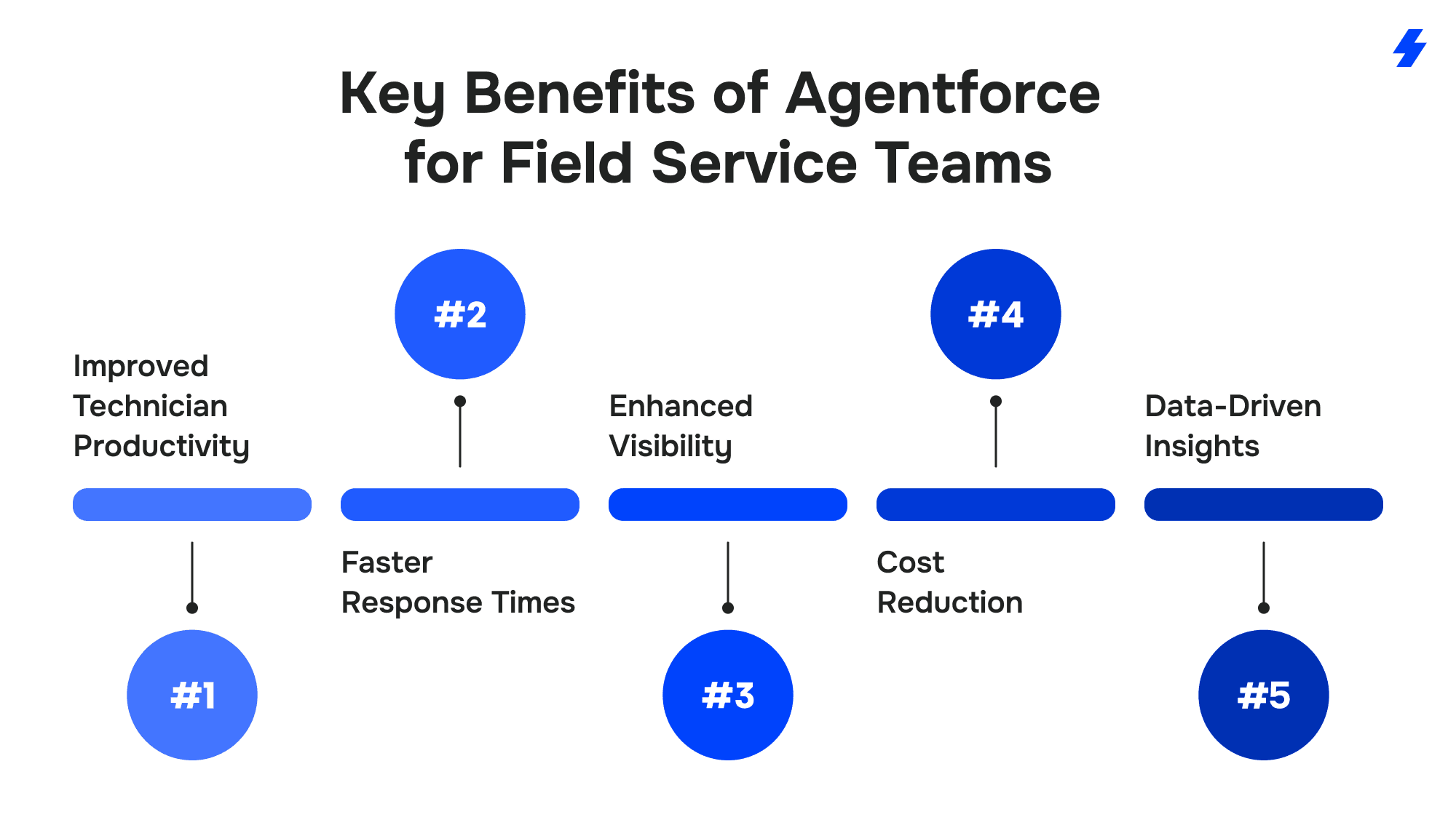
Improved Technician Productivity
Technician productivity is often limited by travel time, idle gaps, and administrative overhead. Agentforce directly addresses these bottlenecks. It automatically builds optimized schedules based on location, skill set, and availability, ensuring technicians spend more time on-site and less time in transit.
Technicians also receive Pre-Work Briefs that summarize customer history, job requirements, and safety notes before arrival. This preparation allows them to complete jobs faster and with fewer errors. Companies like Axis Water have seen technicians start their work 35 minutes earlier per day, significantly increasing the number of jobs completed per week without adding new staff.
Faster Response Times
Speed is critical in field service, especially for industries like utilities, telecom, and roadside assistance where delays can damage customer trust. Agentforce accelerates every stage of the response process, from initial scheduling to on-site troubleshooting.
AAA, for example, reduced its average response time by five minutes per call using Agentforce automation. Multiplied across thousands of jobs, this improvement equates to saving over 20,000 days of cumulative response time annually. Faster dispatching not only delights customers but also frees up capacity to handle more service requests each day.
Enhanced Visibility
Operational visibility is essential for managing large field teams, yet many organizations still rely on fragmented tools and delayed reporting. Agentforce centralizes this information in real time.
Dispatchers and managers can monitor technician locations, job progress, and appointment statuses on live dashboards, while the AI surfaces schedule gaps and suggests how to fill them. This continuous feedback loop enables managers to reallocate resources on the fly, prevent SLA breaches, and proactively address potential bottlenecks before they cause delays.
Cost Reduction
Inefficient scheduling and routing are major cost drivers in field service operations. They increase travel time, fuel consumption, overtime pay, and equipment wear.
Agentforce optimizes schedules and routes based on live traffic, part availability, and technician proximity. By reducing unnecessary truck rolls by up to 20%, it cuts fuel and vehicle maintenance expenses while lowering overtime. These savings compound quickly, turning Agentforce from a cost center into a profit multiplier.
Data-Driven Insights
Agentforce is powered by Salesforce Data Cloud, which unifies service histories, asset data, and IoT telemetry across systems. This gives managers a complete picture of operational performance and customer trends.
AI-driven analytics, powered by Einstein AI, highlight which technicians consistently achieve high first-time-fix rates, which regions experience recurring delays, and where resource imbalances exist. These insights enable service leaders to make evidence-based staffing, training, and investment decisions that continuously improve field service outcomes over time.
Crucially, this level of intelligence is only possible given sufficient data integration across Field Service and Salesforce Data Cloud, ensuring that historical service records, IoT sensor streams, and operational data are unified for accurate, predictive insights.
Real-World Use Cases
These real-world examples show how Agentforce is making a difference across industries. Each case illustrates measurable improvements in operations, customer experience, and financial outcomes.
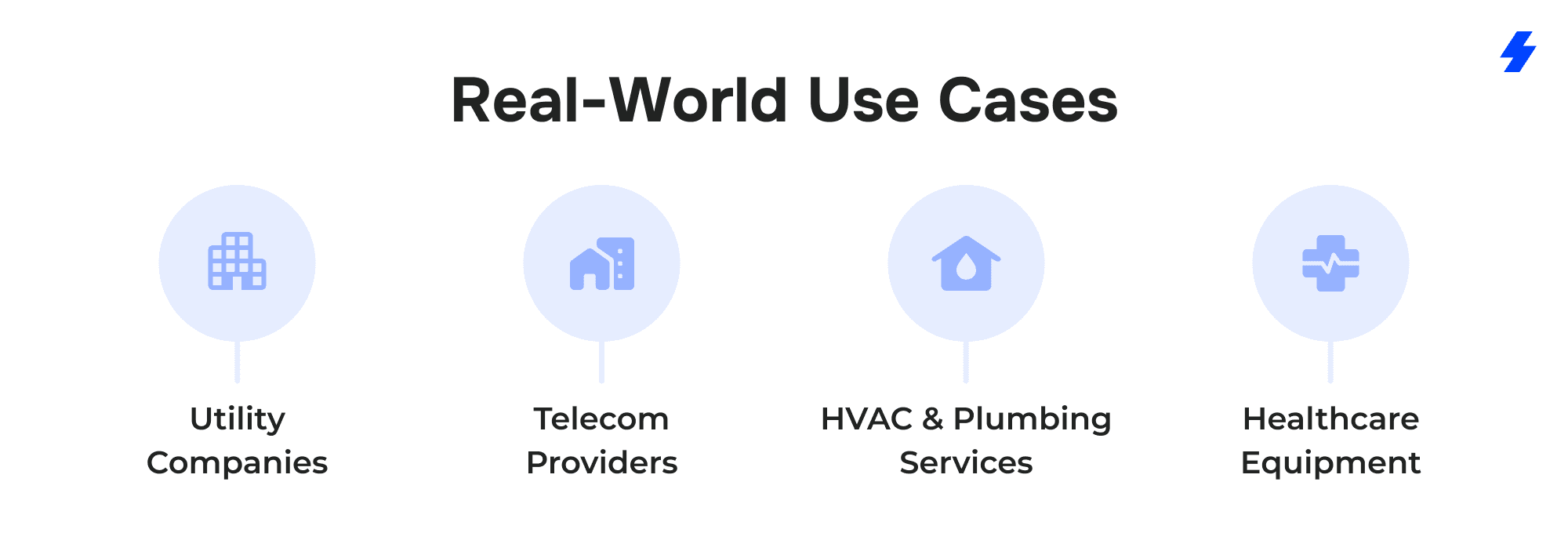
Utility Companies
Agentforce helps utilities manage field operations more proactively, especially around emergencies, preventive maintenance, and asset health. By integrating IoT data, smart meters, weather telemetry, and grid analytics, Agentforce can help trigger proactive work orders when IoT sensors and predictive rules detect potential issues.
- In the Energy & Utilities Cloud specific Agentforce use-case, applications include predictive grid maintenance (e.g. detecting transformer or pipeline risks ahead of failure), dynamic scheduling during storms, and automated customer outage alerts.
- This improves responsiveness during emergencies, reduces unplanned downtime, and shifts costs from reactive repairs to planned maintenance.
- Multi-department benefit: Operations reduce emergency workload; customer service improves transparency (alerts, forecasts); finance can better budget for preventive work vs. costly emergency repairs.
Telecom Providers
Telecom providers use Agentforce to reduce missed appointments, optimize technician travel, and improve first-time fix rates via on-site guidance and improved diagnostics.
- For example, CSPs use Agentforce to analyze prior job history, photos, and sensor data to troubleshoot onsite issues, reducing the need for return visits.
- They also benefit from predictive routing and schedule gap reductions, which helps cut travel time and partial idle windows in technicians’ days.
- Metrics: CPI Security (a telecom/security provider) reported 30% fewer “Where is my technician?” calls and 2.5% drop in overall service-call volume after Agentforce deployment.
HVAC & Plumbing Services
These service industries see large gains by using Agentforce to schedule preventive maintenance, handle routine parts needs, and reduce emergency breakdowns.
- Example: Axis Water, after implementing Agentforce, boosted technician productivity by 30+ minutes every day, cut onboarding time for new techs by 75%, and increased first-visit resolution through pre-work briefs.
- Another HVAC-manufacturer example in Salesforce’s announcement shows that when units hit usage or performance thresholds, Agentforce automatically alerts customers (via SMS), offers service appointments, and handles the scheduling conversation end-to-end.
- Benefits: operations get earlier detection of failures; customer service improves with fewer emergency calls; finance can plan maintenance spend more accurately.
Healthcare Equipment
In healthcare, field engineers must maintain critical equipment under tight regulatory, safety, and uptime requirements. Agentforce helps ensure that service requests are handled quickly and correctly, minimizing risk to patients.
- Field engineers receive real-time updates on service requests and can use Agentforce’s troubleshooting capabilities (including analyzing past repairs, manuals, and sensor data) to improve repair accuracy and speed.
- Also, by using pre-work summaries and voice-driven guidance, technicians arrive on site better prepared, reducing delays and repeat visits.
- Multi-department benefits: clinical staff get more reliable equipment; operations can plan backup/spare parts more precisely; financial risks from downtime and penalties are reduced.
Implementation Mistakes to Avoid
Even the best AI tools fail without careful rollout. Here are the most frequent mistakes companies make during Agentforce Field Service implementations and how MagicFuse helps avoid them:
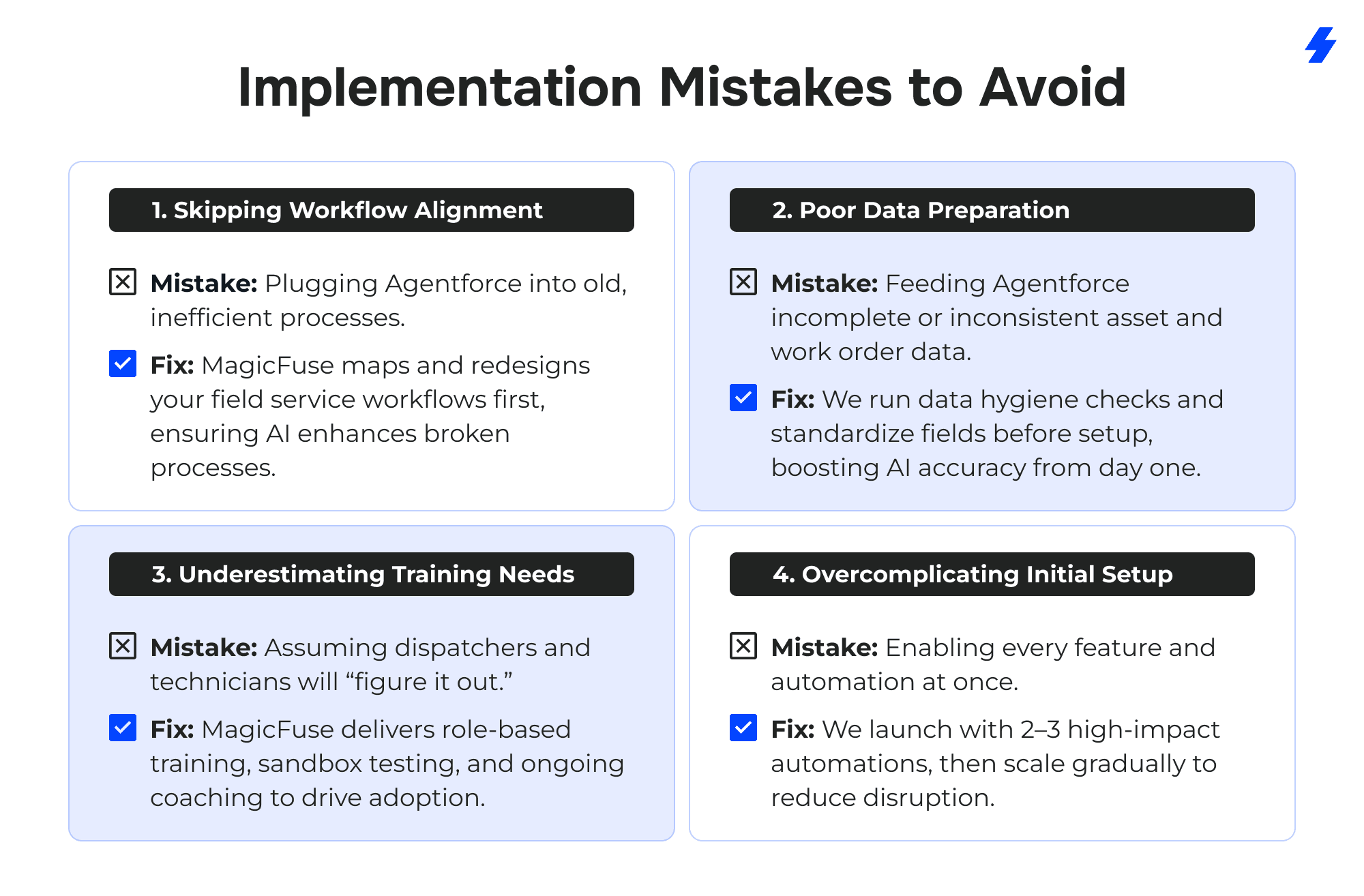
Skipping Workflow Alignment
Mistake: Plugging Agentforce into old, inefficient processes.
Fix: MagicFuse maps and redesigns your field service workflows first, ensuring AI enhances broken processes.
Poor Data Preparation
Mistake: Feeding Agentforce incomplete or inconsistent asset and work order data.
Fix: We run data hygiene checks and standardize fields before setup, boosting AI accuracy from day one.
Underestimating Training Needs
Mistake: Assuming dispatchers and technicians will “figure it out.”
Fix: MagicFuse delivers role-based training, sandbox testing, and ongoing coaching to drive adoption.
Overcomplicating Initial Setup
Mistake: Enabling every feature and automation at once.
Fix: We launch with 2–3 high-impact automations, then scale gradually to reduce disruption.
Step-by-Step Guide for Implementing Agentforce in Field Service
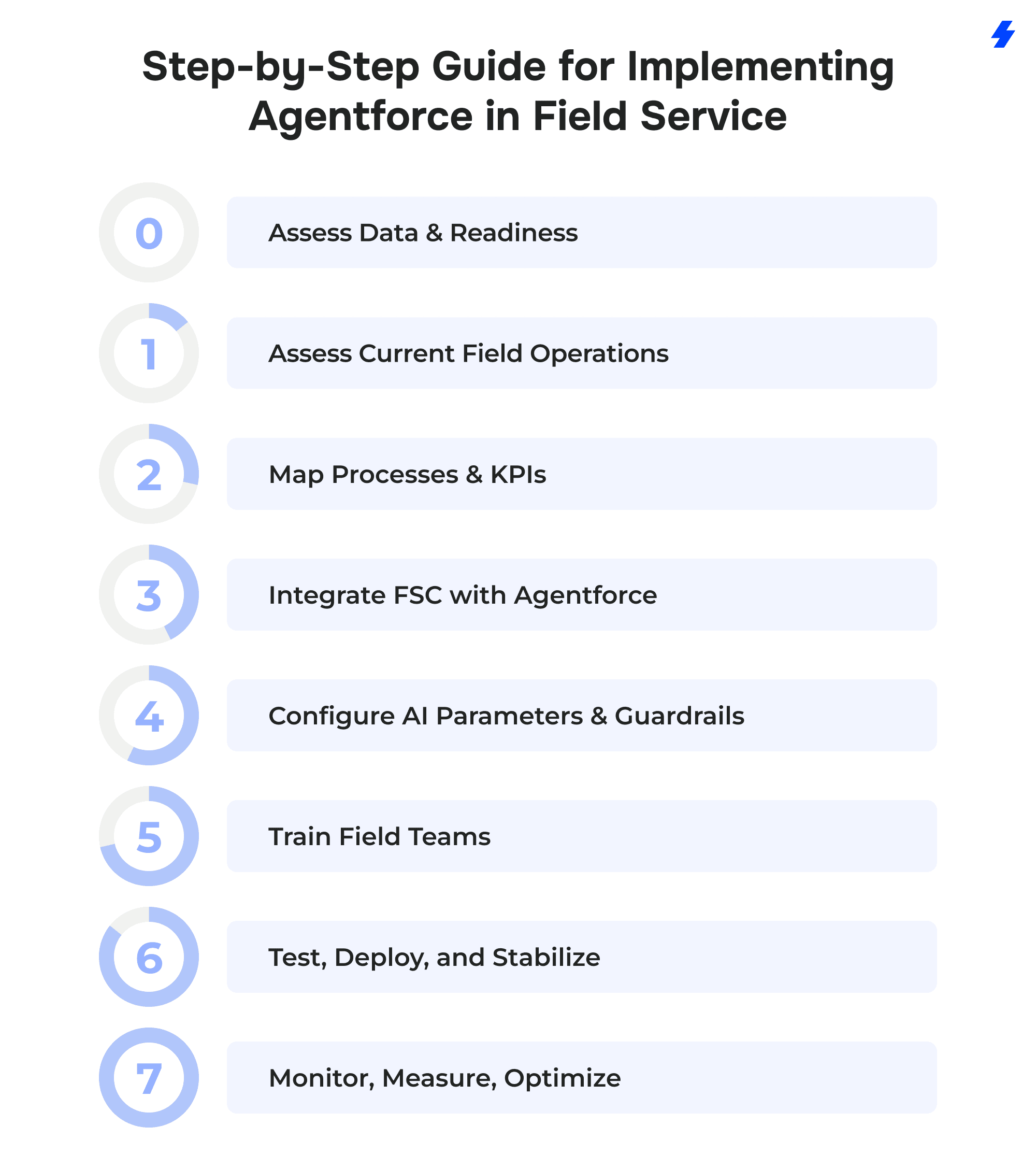
Step 0: Assess Data & Readiness (Start Here)
Before anything else, validate the quality, completeness, and security of the data Agentforce will act on. Unify service histories, assets, inventory, and (if used) IoT signals in Data Cloud; standardize picklists (e.g., Work Types, Parts, Territories), cleanse duplicates, and confirm permissioning. Decide early where autonomy vs. human review is required, and document any sensitive-data guardrails. A clean, governed dataset prevents “junk-in/junk-out” and builds trust in AI outcomes.
Step 1: Assess Current Field Operations
Capture your baseline so you can prove ROI later. Map bottlenecks across scheduling, routing, dispatch, and wrap-up. Record KPIs such as first-time-fix, average travel time per job, truck-roll rate, SLA attainment, and admin time per work order. Gather dispatcher/technician feedback about daily friction (gap fills, no-shows, missing parts, offline mobile needs).
Step 2: Map Processes & KPIs
Document the end-to-end flow (Case → Work Order → Service Appointment → Post-Work Summary). Define objective trade-offs for optimization (e.g., SLA-first vs. mileage-first vs. utilization-first) and set clear targets (e.g., –20% travel time, +10% jobs/day, –15% overtime). Align roles: what dispatchers approve, what techs do hands-free, and what managers monitor.
Step 3: Integrate FSC with Agentforce
Confirm Field Service core objects and the mobile app are configured (Service Territories, Service Resources, Skills, Work Types). Connect Data Cloud so Agentforce can ground actions in unified customer/asset data. Enable Agentforce in Setup, provision licenses/permissions, and expose agents where work happens: Dispatcher Console and Field Service Mobile.
Step 4: Configure AI Parameters & Guardrails
Translate your policies into Agentforce behavior:
- Scheduling policies: weight skills, certifications, proximity, traffic, parts availability, and SLAs.
- Gap-resolution rules: define when to auto-suggest vs. require dispatcher approval.
- Predictive triggers: usage thresholds or sensor signals that auto-propose maintenance work.
- Knowledge grounding: connect manuals, prior jobs, and FAQs for guided troubleshooting.
- Autonomy limits: specify which actions agents can complete end-to-end (e.g., booking/rescheduling within windows) and which require human sign-off (e.g., overtime, premium parts).
Step 5: Train Field Teams (Role-Based, Hands-On)
Drive adoption with practical training in the flow of work:
- Dispatchers: using AI scheduling suggestions, one-click gap fills, and exception handling.
- Technicians: Pre-Work Brief playback, Siri shortcuts, voice prompts for troubleshooting, and drafting Post-Work Summaries.
- Managers: live dashboards, KPI reviews, and policy tuning. Use quick-reference guides and short simulations; nominate champions to handle day-1 questions.
Step 6: Test, Deploy, and Stabilize
Pilot with a contained territory or team. Test real scenarios (cancellations, parts delays, offline mobile) and validate outcomes before a phased rollout. Package Topics, Actions, Prompts, and Flows together; promote through sandboxes to production with repeatable DevOps steps. Establish a hypercare window for rapid tweaks.
Step 7: Monitor, Measure, Optimize (Continuous Loop)
Instrument dashboards for your baseline KPIs and track improvement weekly. Tune scheduling weights (e.g., SLA vs. mileage), refine prompts, and adjust autonomy thresholds based on frontline feedback. Expand use cases (e.g., preventive maintenance triggers, inventory checks) once core scheduling and wrap-up are stable.
Integration Tips for Hybrid Field Operations
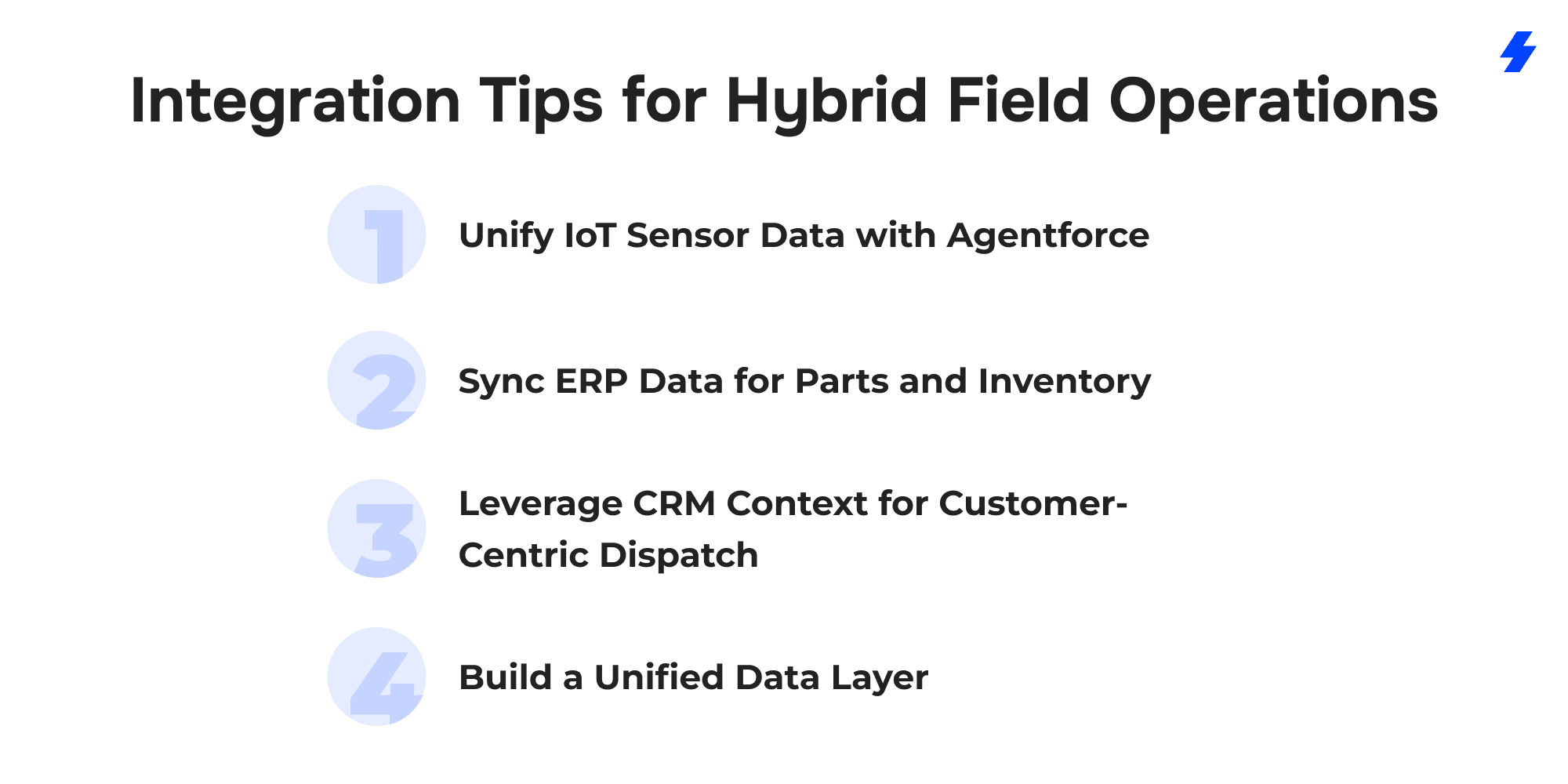
Unify IoT Sensor Data with Agentforce
Connect your field equipment’s IoT sensors to Salesforce Data Cloud. This allows Agentforce to access real-time performance metrics (like temperature, vibration, or energy consumption) and trigger automated maintenance workflows.
- Use MuleSoft or Salesforce Platform Events to ingest sensor streams into Data Cloud.
- Map sensor data to Asset and Work Order objects so Agentforce can detect early failure patterns.
- Example: When vibration thresholds are exceeded, Agentforce can automatically open a case, schedule a technician, and attach recent sensor history to the work order.
Sync ERP Data for Parts and Inventory
Integrating ERP systems ensures Agentforce schedules only jobs that have required parts in stock, reducing first-time-fix failures.
- Use MuleSoft Anypoint Connectors to sync ERP inventory data to Salesforce Assets and Products.
- Create a Flow to prevent scheduling if required parts are below minimum stock.
- Example: Before dispatching a technician for compressor repair, Agentforce verifies part availability in real time and delays scheduling if restock is needed.
Leverage CRM Context for Customer-Centric Dispatch
CRM integration gives dispatchers and agents full customer context during scheduling and troubleshooting.
- Ensure Service Cloud Cases and Field Service Work Orders are linked to Accounts and Contracts.
- Agentforce can prioritize high-SLA customers or VIP contracts automatically.
- Example: If a premium customer logs a support issue, Agentforce can push it to the top of the dispatch queue and notify the assigned technician with client history.
Pro Tip: Build a Unified Data Layer
Keep all three systems (IoT, ERP, and CRM) in sync through Data Cloud. This allows Agentforce’s predictive models to combine equipment health, part availability, and customer priority into a single optimization decision.
Agentforce vs Legacy Field Service Automation Tools
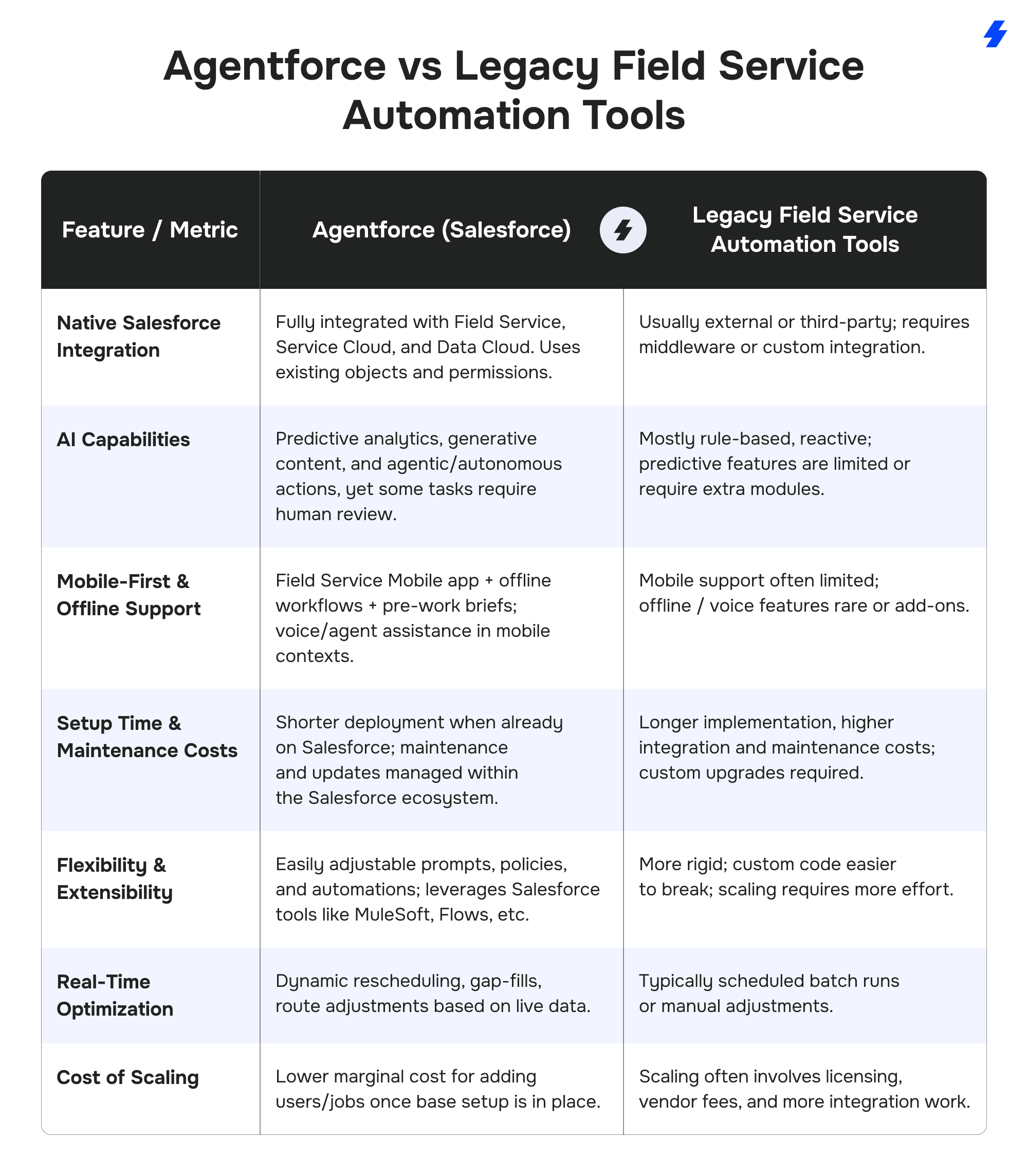
Pricing & Licensing Overview
Agentforce for Field Service is an add-on that brings AI agents (assistive + action-taking) into Salesforce Field Service. You can either:
- Add Agentforce for Field Service to existing Enterprise/Unlimited Field Service orgs, or
- Buy an Agentforce 1 Field Service Edition bundle (Field Service + built-in AI + data/analytics).
Headline Prices & What’s Included
Agentforce for Field Service add-on: $125/user/month (billed annually). Includes assistive AI for dispatchers & mobile workers (Employee Agent), Resolve Schedule Gaps, Schedule Summary, Pre-Work Brief, on-site knowledge search, Asset Health Score, and more.
Agentforce 1 Field Service Edition: Salesforce lists a bundled Field Service edition with AI and unified data (pricing shown at the Field Service pricing page; edition selection determines total). Use this route if you want a consolidated SKU with Field Service + AI + data/analytics from day one.
Note: Pricing may vary; consult Salesforce for exact licensing costs and any applicable volume or enterprise agreements.
Related add-ons commonly paired with Field Service:
- Asset Service Lifecycle Management: $75/user/month
- Visual Remote Assistant: from $50/user/month
- Appointment Assistant: from $25/user/month (Useful for building a complete service stack around Agentforce.)
Success plans: Standard is included; Premier is typically 30% of net license fees; Signature is bespoke. Factor these into TCO if you want expedited support and proactive guidance.
Public Sector & Upper-Tier Pricing (Context)
For government buyers, Salesforce now markets Agentforce 1 Public Sector editions and add-ons; published materials show $150/user/month for the Agentforce Public Sector add-on and $650/user/month for “Public Sector – Service – Agentforce 1 Edition” (comprehensive stack).
How Salesforce Tiers Pricing in Practice
Pricing typically scales with:
- User count & roles (dispatchers, techs, managers)
- Job volume & optimization features (e.g., schedule gap resolution, knowledge search)
- Edition choice (add-on vs. Agentforce 1 bundle) and industry/sector packaging
Salesforce’s 2025 pricing update also introduced Agentforce 1 Editions (broader bundles) and reaffirmed $125/user/month starting price for Agentforce add-ons, plus credits/analytics entitlements in some bundles.
Modeling ROI (What to Tell Finance)
- Cost reduction: AI gap-filling and routing lower overtime and fuel; self-service scheduling deflects contact-center load (Appointment Assistant can complement).
- Productivity gains: Pre-Work Briefs and on-site knowledge search increase first-time-fix and reduce wrap-up time.
- Faster SLA fulfillment: Optimization + real-time updates keep SLAs intact and compress arrival windows.
- Executive analytics: Operations suite (Tableau Next) in certain Agentforce packages accelerates decision-making on staffing, parts, and territories.
Quick rule of thumb: start with the $125/user/month add-on for dispatchers + techs, then add Appointment Assistant and/or Visual Remote Assistant where deflection or remote fix rates drive measurable savings. Move to an Agentforce 1 edition when you want bundled AI + data credits and standardized entitlements across service teams.
ROI Calculator for Agentforce Field Service
What It Does:
Salesforce provides an ROI calculator that lets you model how Agentforce will improve your Field Service operations before you invest. It’s designed to show data-driven projections of cost savings, productivity gains, and efficiency boosts based on your real-world numbers. These results are projections only and are not guaranteed.
How It Works:
- Choose Field Service–specific use cases such as Appointment Scheduling and Customer Service Automation.
- Enter your team size, daily job volume, average travel time, and case resolution times.
- The calculator estimates: reduction in travel time and scheduling gaps using AI-driven dispatch, higher first-time fix rates from predictive troubleshooting, lower overtime, fuel, and SLA penalty costs, and increased technician productivity and customer satisfaction scores.
- Results are benchmarked against Salesforce’s global dataset from thousands of service organizations.
Companies using the calculator typically see projected results like:
- 25–35% less travel time
- 15–20% more jobs completed per technician per week
- 10–20% faster SLA resolution rates
The calculator also estimates how many Flex Credits your chosen AI use cases will consume, helping forecast costs and ROI together. For example, Appointment Scheduling uses credits per action, while Pre-Work Briefs and predictive diagnostics are included in the Agentforce for Field Service license.
Competitor Analysis
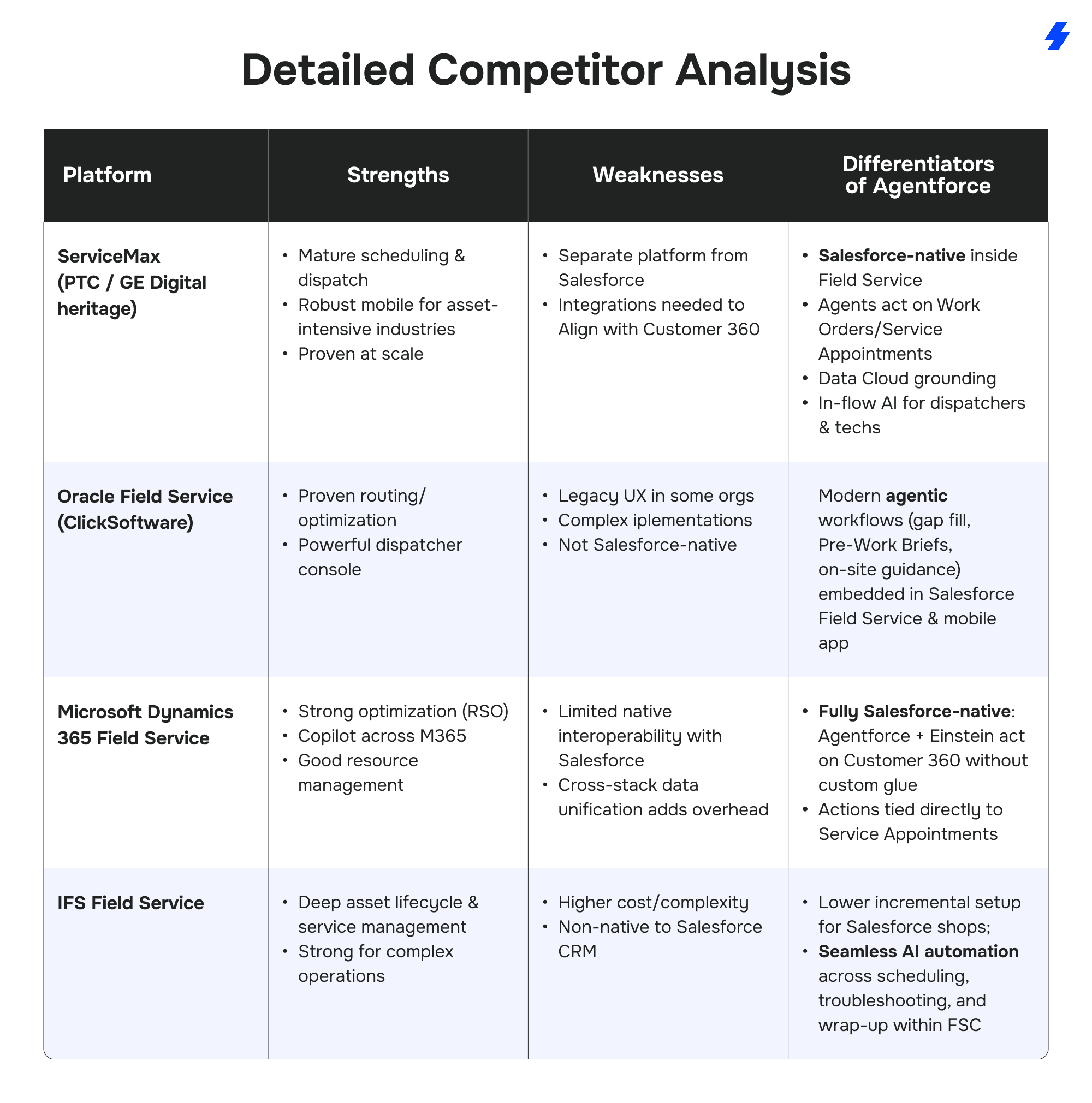
Why Choose MagicFuse for Agentforce Field Service Implementation
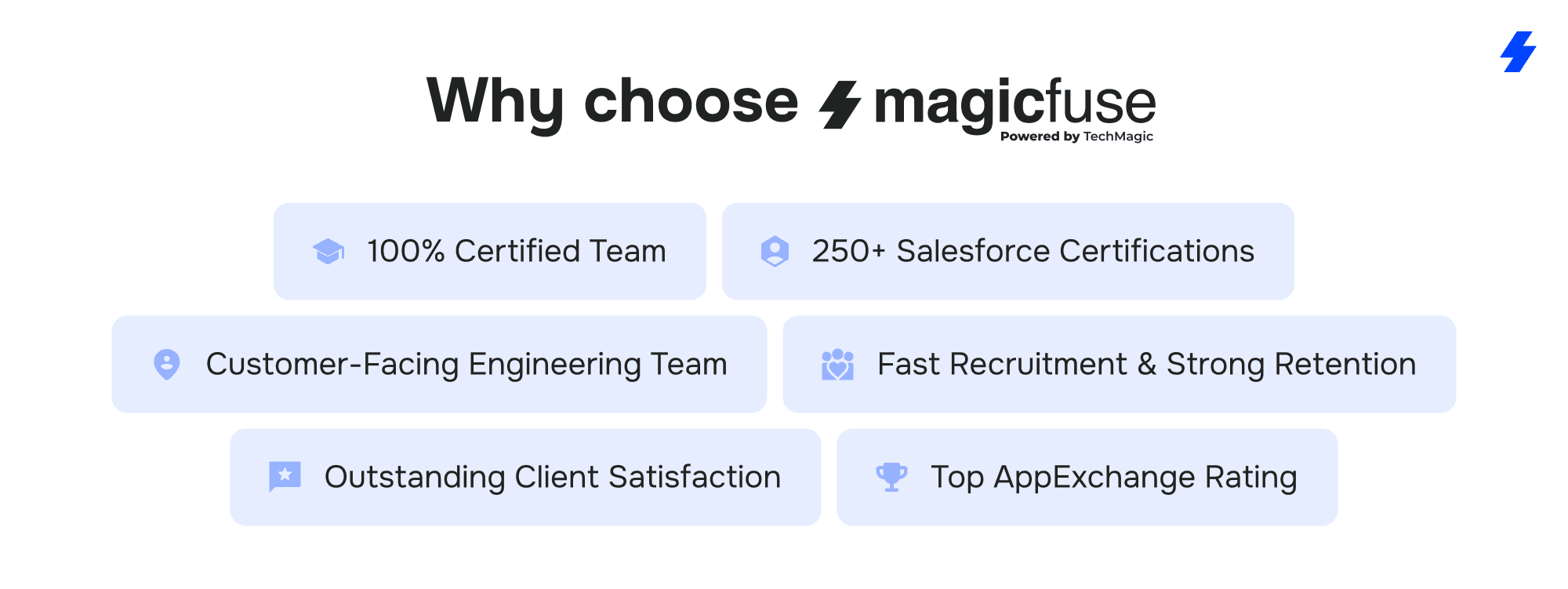
100% Certified Team
Our entire engineering team holds Salesforce certifications, ensuring expert-level knowledge and the skills required to deliver reliable, high-quality solutions for your field operations.
250+ Salesforce Certifications
With over 250 certifications earned, including Experience Cloud Consultant, Data Cloud Consultant, B2B Solution Architect, we stay ahead of the curve to support your evolving needs.
Proven Field Service Experience
With 11+ years of implementing Salesforce Field Service solutions, we’ve solved complex scheduling, routing, and mobile workforce challenges across industries.
Customer-Facing Engineering Team
We offer full transparency. Clients work directly with our engineers, without unnecessary management layers, enabling smooth collaboration and faster problem-solving.
Fast Recruitment & Strong Retention
We recruit top Salesforce experts in as little as 6 weeks and maintain an average employee retention of 3+ years, ensuring consistent expertise on your projects.
Outstanding Client Satisfaction
Our commitment to quality is reflected in a Net Promoter Score of 92%, proving that clients trust and recommend our services.
Top AppExchange Rating
With a 4.9-star rating on Salesforce AppExchange, MagicFuse has earned its reputation as a reliable and customer-focused Salesforce partner.
Contact MagicFuse for a rollout plan tailored to your field KPIs (SLA, travel time, FTFR).
FAQs
What is Agentforce for Field Service?
Agentforce for Field Service is Salesforce’s digital labor platform built to change the field service sector. It uses AI agents to automate scheduling, optimize service delivery, and assist field service workers with real-time guidance.
How does Agentforce improve technician productivity?
By reducing time consuming administrative tasks and eliminating back and forth scheduling, Agentforce enables early job completions and more faster service. The field service mobile app gives workers relevant information like customer’s service history, traffic data, and job wrap up steps.
Can Agentforce integrate with existing data systems?
Yes. It connects with ERP, CRM, and IoT sensor data, using relevant structured data and unstructured data to make context aware decisions. This helps organizations handle real world nuances in scheduling and troubleshooting issues onsite.
What industries benefit most from Agentforce?
Critical sectors such as automotive services, consumer home services, utilities, and roadside service delivery gain immediate value. From the auto club group to skilled workers in critical industries, Agentforce helps resolve schedule gaps and reduces overall call volume.
How does Agentforce impact employees and customers?
By removing inefficient scheduling and time consuming tasks that plague field workers today, Agentforce drives improved employee morale, builds stronger customer relationships, and leads to increased customer satisfaction.
How does Agentforce redefine field service?
This marks the beginning of a new era in workforce transformation, where digital capabilities and skilled professionals collaborate seamlessly. Leveraging natural language interaction, modern messaging channels, and real-time data, Agentforce drives significant improvements in responsiveness and operational efficiency.
Is Agentforce the same as Copilot?
No. Copilot offers conversational help, while Agentforce automates appointment scheduling, resolves schedule gaps, and executes business rules directly in the field service app, turning guidance into autonomous action.
How can MagicFuse help with implementation?
With expertise across Salesforce’s industry clouds, MagicFuse ensures smooth integration of Field Service Agentforce into your field service operations. We optimize customer operations, leverage key data points, and help achieve accelerated growth with measurable ROI.















